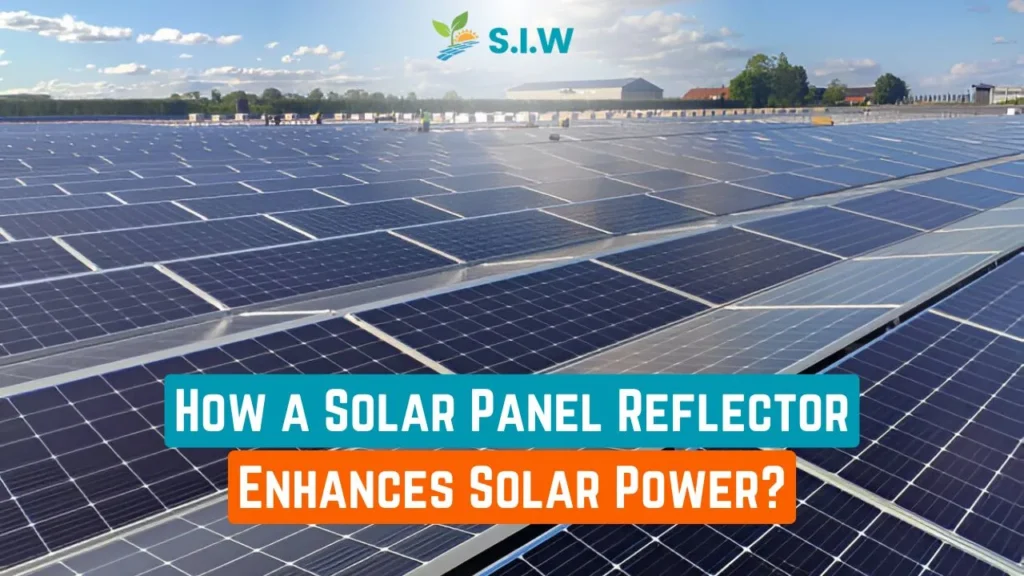As solar energy is becoming more and more important in the global energy scene, strategies to maximize solar panel efficiency have developed with developing technologies. Among these developments, solar panel reflectors are most important in increasing energy output by focusing more sunlight onto photovoltaic (PV) cells. The operation of solar panel reflectors, their advantages, and their enhancement of general solar power efficiency will be discussed in this paper.
What is a Solar Panel Reflector?
An auxiliary meant to focus sunlight towards solar panels is a solar panel reflector. Solar panel reflectors can greatly raise energy output by boosting the sunlight that strikes the photovoltaic cells. Usually composed of highly reflective materials like aluminum or specialized mirrors able to resist outdoor conditions, these reflectors are highly effective.
Reflectors absorb sunlight that would otherwise miss the panel and reroute it onto the solar cells, therefore operating on a basic but useful premise. Higher energy generation results from this increased total irradiation on the surface of the panel. Attached directly to current panels or placed in the surrounding area, solar panel reflectors help to focus more light toward them.
The Science Supporting Solar Panel Reflectors
First, we must learn the fundamentals of solar panel operation before we can appreciate how reflectors improve solar output. PV cells—which use the photovoltaic effect to turn sunlight into electricity—make up solar panels. Sunlight exciting electrons in these cells creates an electric current.
Not all sunlight, though, that comes onto a solar installation strikes the panels exactly. A bit of it can be scattered or reflected away. By guiding extra sunlight lost otherwise, solar panel reflectors seek to lower this waste. This mechanism raises the incident solar radiation of the panel, therefore producing more power.
Varieties of Solar Panel Reflectors
Each of the numerous kinds of solar panel reflectors is meant to fit particular installation requirements and environmental surroundings. The most common types are as follows:
1. Fixed-Angle Reflectors
Mounted at a particular angle, fixed reflectors point sunlight towards the solar panels. Usually positioned at an optimum angle depending on the latitude of the area, these reflectors remain motionless. Fixed reflectors are a reasonably priced and lasting choice for solar power systems due to their simplicity.
2. Tracking Reflectors (Heliostats)
Tracking reflectors—also called heliostats—adjust their orientation over the day to track the movement of the sun. Because these dynamic systems preserve ideal angles to gather and guide sunlight onto the panels, they are more efficient than stationary reflectors. By continuously increasing sunlight exposure, tracking reflectors greatly increase energy output in solar systems, though they are more costly.
3. Specular Reflectors
Specular reflectors are mirrors or polished surfaces with great reflection efficiency through precise light direction. Although they can also be used in PV systems to direct more sunlight onto panels, concentrated solar power (CSP) plants frequently feature these reflectors. When enhancing power generation under low-light or cloud cover, specular reflectors are quite successful.
Advantages of Solar Panel Reflectors
Including reflectors into solar panel systems offers several key advantages:
1. Increased Energy Output
The boost in energy output of solar panel reflectors is their most important benefit. Reflectors increase solar cell efficiency by increasing the sunlight reaching the panels. Depending on geographical location and reflector design, studies have indicated that systems including reflectors can see a 20–30% energy production increase.
2. Reduced Installation Costs
To achieve the same power output, adding reflectors to a solar panel system is sometimes more reasonably priced than adding more panels. For budget-conscious clients who want to maximize energy output without expanding panel area, reflectors are an appealing alternative.
3. Space Optimization
Reflectors can greatly raise solar system power generation capacity in areas with limited space. Reflectors are perfect for residential and urban installations since they allow existing installations to generate more electricity within the same footprint, eliminating the need for extra panels.
4. Improved Performance in Suboptimal Conditions
Reflectors help solar panels run more efficiently in areas with less-than-ideal sunlight conditions, such as frequent cloud cover or low solar angles. These devices maximize solar installation effectiveness even during off-peak hours by focusing dispersed or low-angle sunlight.
Factors Affecting Solar Reflector Integration
Although reflectors offer many benefits, their integration requires careful planning. Reflector placement, panel orientation, and environmental factors all influence the efficiency of these systems. Key considerations include:
1. Angle and Orientation
Reflectors must be positioned at optimal angles to efficiently capture and reroute sunlight. Proper alignment is essential to maximize efficiency, and the angle should be adjusted based on the location’s solar path.
2. Material Durability
Reflectors must be made of highly reflective, durable, and weather-resistant materials to withstand conditions such as rain, dust, and snow. Popular options include aluminum and glass mirrors due to their high reflectivity and weather resistance.
3. Cost vs. Benefit Analysis
Although reflectors can boost energy output, their cost must be weighed against the overall benefit. In some cases, especially in areas with abundant sunlight, additional solar panels may provide a more cost-effective solution. However, in locations with limited space or suboptimal sunlight, reflectors offer a practical way to enhance solar power generation.
The Future of Solar Panel Reflectors
The integration of reflectors in solar energy systems is a growing trend, especially as more homeowners and businesses look to increase efficiency in renewable energy solutions. Advances in materials science and solar tracking technology continue to make reflectors more accessible and effective. As solar panel technology advances, reflectors will play an increasingly important role in the future of solar energy.
Further Reading and Research on Solar Panel Reflectors
For further reading, consider exploring studies on the impact of reflectors on solar power generation efficiency, such as research published by the National Renewable Energy Laboratory (NREL) and the International Renewable Energy Agency (IRENA). These resources provide in-depth analysis and case studies on reflector performance in diverse solar installations.








